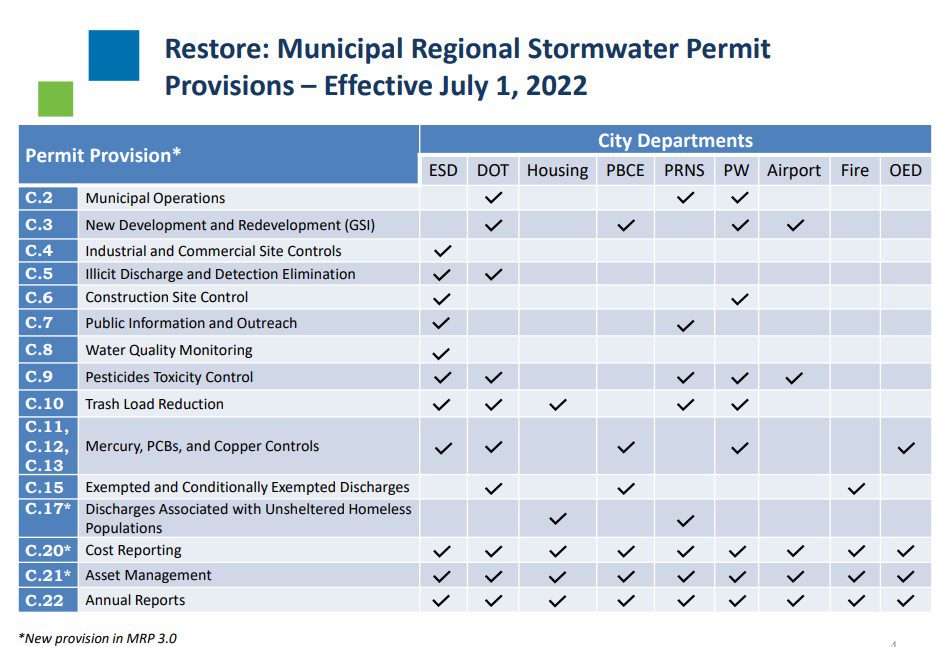The San Jose City Council agenda last week had an innocuous item called the Municipal Regional Stormwater Permit Reissuance. It was previously discussed during the Dec. 5 Transportation and Environment Committee meeting. The new five-year stormwater permit became effective July 1, 2022 and expires July 2027.
If you want to know how much you should be concerned by this item, just look at the executive summary language:
There are significant changes compared to previous permits that will impact several existing programs and will require additional new programs that will focus on protecting the storm sewer system and waterways. Compliance with the stormwater permit may require the city to increase certain permit fees. Even so, additional funding is needed for the city to support programs and ongoing maintenance needs in order to comply with the stormwater permit and Clean Water Act.
Significant doesn’t even scratch the surface of what this is going to do for the future of development of both commercial and residential properties, and the elimination of 100% trash from storm sewer and waterways. This new regulation will even affect washing down sidewalks. Gone are the days of washing it down with a hose and letting it go into the gutter, according to a city memo:
The stormwater permit requires the enhancement of best management practices for washing down sidewalks, plazas and other paved areas particularly on surfaces impacted by human habitation which include sanitizing procedures. Cleaning and sanitizing these surfaces generate pollutants that must not enter the storm drain and requires additional time and specialized tools and procedures to complete in a compliant manner. This requirement will affect businesses and public spaces impacted by these activities and add additional financial burden to be compliant.
This includes homeless people living within 500 feet of creeks and services provided to them. If you need a reminder of the herculean task of moving an encampment, check out this San José Spotlight story about Columbus Park.
That was caused by a Federal Aviation Administration order to clear the encampment. There will be similar directives over time to ensure the creeks are not being polluted by the homeless. At Columbus Park they removed 1 million pounds of debris from the 25-acre section. Just imagine what cleaning up the creeks on an ongoing basis will take.
City workers were cavalier about the complexity of this item by comparing it to solving a Rubik’s cube. It’s not a Rubik’s cube — it’s an infrastructure tsunami. There are 35,000 inlets in San Jose, and each flows to a creek or river.
City officials would not say what it will cost to comply with this new regulation. Common sense says to look at previous infrastructure costs, homeless encampment sweeps and housing development costs — and it could end up costing hundreds of millions of dollars.
On the front end it will require nine separate city departments and millions of dollars of consultant work to devise the plan. 

The previous permit required zero single-family residential properties to comply with it. This time around: 13,983 properties.
That’s not an insignificant number of residential properties. If they need to comply with this permit, it could potentially cost tens of thousands of dollars per property. There will be a requirement for staff review and a catch basin on private property that connects to another in the public right of way.
The bottom line is it will require coordination between numerous city departments and other governmental agencies, as well as a significant amount of money each year. This is not an unfunded liability or something that Caltrans or some other group will fund. The onus will land on San Jose. How will those costs be pushed down to the residents of San Jose? Will it be a bond measure like Measure T or will the city increase fees and fines dramatically to cover this permit?
This is the first test of the common sense, accountability and transparency era of San Jose. Don’t hold your breath for community meetings to bring the magnitude of this issue to light, as Measure T lacked public input.
This is looking like another backroom idea crammed down the public’s pocketbooks. Let your voice be heard before it’s too late to provide input.
San José Spotlight columnist Bob Staedler is a principal at Silicon Valley Synergy, a San Jose-based land use and development consulting firm. His columns appear every first Monday of the month. Contact Bob at [email protected] or follow @BobStaedler on Twitter.



Leave a Reply
You must be logged in to post a comment.